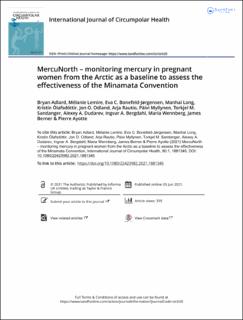| dc.contributor.author | Adlard, Bryan | |
| dc.contributor.author | Lemire, Mélanie | |
| dc.contributor.author | Bonefeld-Jørgensen, Eva Cecilie | |
| dc.contributor.author | Long, Manhai | |
| dc.contributor.author | Ólafsdóttir, Kristín | |
| dc.contributor.author | Odland, Jon Øyvind | |
| dc.contributor.author | Rautio, Arja | |
| dc.contributor.author | Myllynen, Päivi | |
| dc.contributor.author | Sandanger, Torkjel M | |
| dc.contributor.author | Dudarev, Alexey A. | |
| dc.contributor.author | Bergdahl, Ingvar A. | |
| dc.contributor.author | Wennberg, Maria | |
| dc.contributor.author | Berner, James | |
| dc.contributor.author | Ayotte, Pierre | |
| dc.date.accessioned | 2021-07-13T08:53:03Z | |
| dc.date.available | 2021-07-13T08:53:03Z | |
| dc.date.created | 2021-07-02T10:16:06Z | |
| dc.date.issued | 2021 | |
| dc.identifier.citation | International Journal of Circumpolar Health. 2021, 80, 1881345. | en_US |
| dc.identifier.issn | 1239-9736 | |
| dc.identifier.uri | https://hdl.handle.net/11250/2764251 | |
| dc.description.abstract | Exposure to mercury (Hg) is a global concern, particularly among Arctic populations that rely on the consumption of marine mammals and fish which are the main route of Hg exposure for Arctic populations.The MercuNorth project was created to establish baseline Hg levels across several Arctic regions during the period preceding the Minamata Convention. Blood samples were collected from 669 pregnant women, aged 18–44 years, between 2010 and 2016 from sites across the circumpolar Arctic including Alaska (USA), Nunavik (Canada), Greenland, Iceland, Norway, Sweden, Northern Lapland (Finland) and Murmansk Oblast (Russia). Descriptive statistics were calculated, multiple pairwise comparisons were made between regions, and unadjusted linear trend analyses were performed.Geometric mean concentrations of total Hg were highest in Nunavik (5.20 µg/L) and Greenland (3.79 µg/L), followed by Alaska (2.13 µg/L), with much lower concentrations observed in the other regions (ranged between 0.48 and 1.29 µg/L). In Nunavik, Alaska and Greenland, blood Hg concentrations have decreased significantly since 1992, 2000 and 2010 respectively with % annual decreases of 4.7%, 7.5% and 2.7%, respectively.These circumpolar data combined with fish and marine mammal consumption data can be used for assessing long-term Hg trends and the effectiveness of the Minamata Convention. | en_US |
| dc.language.iso | eng | en_US |
| dc.rights | Navngivelse-Ikkekommersiell 4.0 Internasjonal | * |
| dc.rights.uri | http://creativecommons.org/licenses/by-nc/4.0/deed.no | * |
| dc.title | MercuNorth – monitoring mercury in pregnant women from the Arctic as a baseline to assess the effectiveness of the Minamata Convention | en_US |
| dc.type | Peer reviewed | en_US |
| dc.type | Journal article | en_US |
| dc.description.version | publishedVersion | en_US |
| dc.rights.holder | © 2021 The Author(s). | en_US |
| dc.source.volume | 80 | en_US |
| dc.source.journal | International Journal of Circumpolar Health | en_US |
| dc.identifier.doi | 10.1080/22423982.2021.1881345 | |
| dc.identifier.cristin | 1919994 | |
| dc.source.articlenumber | 1881345 | en_US |
| cristin.ispublished | true | |
| cristin.fulltext | original | |
| cristin.qualitycode | 1 | |

